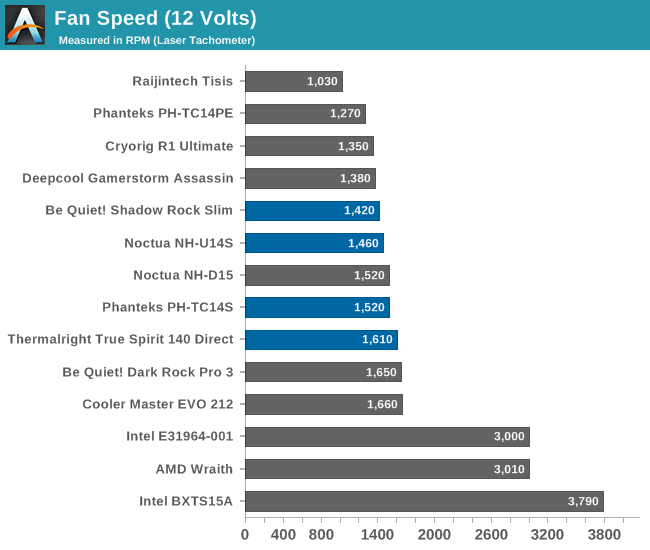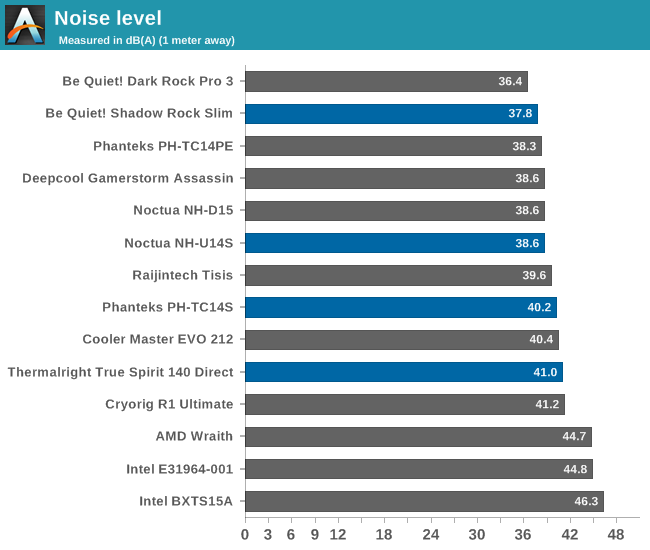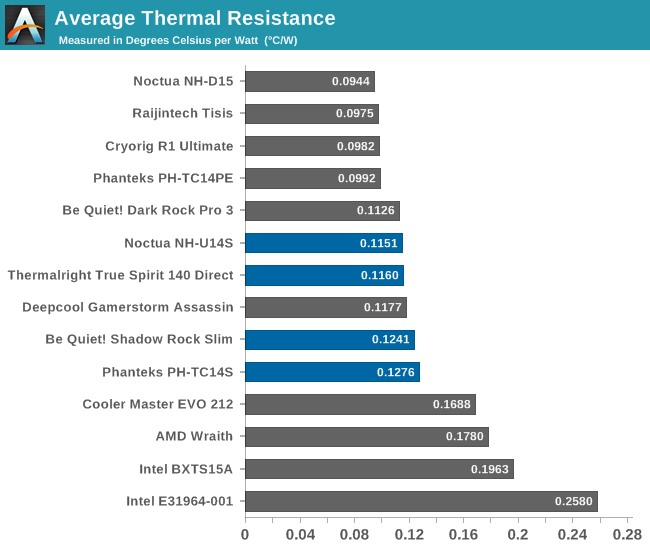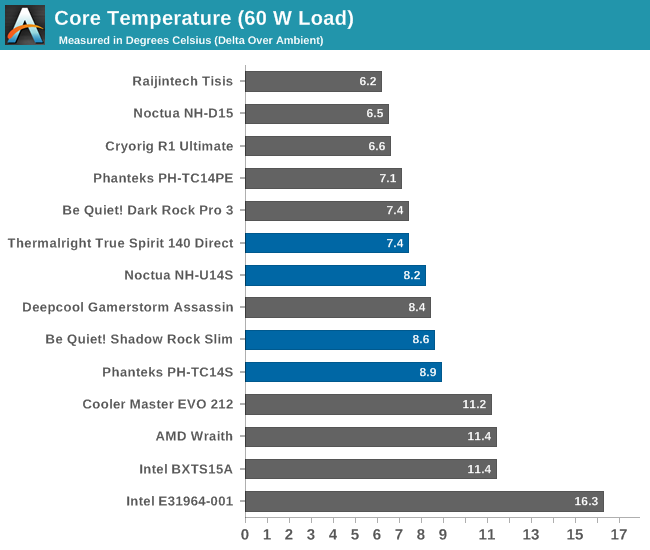The 140mm Slim Tower CPU Cooler Roundup: Thin & Light Done Just Right
by E. Fylladitakis on May 24, 2017 8:00 AM EST- Posted in
- Cases/Cooling/PSUs
- be quiet!
- Noctua
- Phanteks
- Cooler
- Thermalright
Testing Results: Maximum Fan Speed
To start things off, let's take a look at the peak cooling performance of our four tower coolers. We should note that the Phanteks PH-TC14S is once again the oddity of this review, with its fan reaching 1520 RPM. The specifications of the PH-F140HP fan state a very broad maximum speed range of 1300 ± 250 RPM, so our reading is within the fan’s specifications, yet this is the first time that we have encountered a fan spinning that much faster than its rated speed.


With their fans running at their maximum speed, the best overall thermal performance comes from Thermalright’s True Spirit 140 Direct. Noctua’s NH-U14S handles high loads a little better, but Thermalright’s offering has a very strong advantage at lower loads, suggesting more efficient heat transfer due to its direct contact design.

The Be Quiet! Shadow Rock Slim falls a little behind in terms of thermal performance but only by a couple of degrees, which is acceptable considering that it had the lowest noise reading of this review. Considering the overall design of the cooler and that it has a smaller number of heatpipes in comparison to every other cooler in this review, its top speed performance is surprisingly good.

| Core Temperature, Constant Thermal Load (Max Fan Speed) |
Although its thermal performance is satisfactory, the Phanteks PH-TC14S falls behind the other three coolers of this review. It is both slightly louder and less efficient, especially when it has to deal with very high thermal loads. The difference however is small and a more carefully designed revision can easily turn the tables.










74 Comments
View All Comments
Ian Cutress - Wednesday, May 24, 2017 - link
Are you measuring the heatsink, or the product? A lot of these companies go to great lengths to 'optimize' their fan design.fanofanand - Thursday, May 25, 2017 - link
I see this same type of comment applied to GPUs and cases too. Products should be tested exactly as they are sold. If a company wants to get their price under $x and they skimp on the case fans to do it, the reader should know that so they can price it appropriately by adding in the cost of good fans. Conversely if a company's price is higher but out of the box has the performance you would achieve from changing out the fans then that should be acknowledged and the reader be made aware. The way Anandtech does it is absolutely appropriate and allows the reader to get an accurate picture of what they are getting for the money.snarfbot - Thursday, May 25, 2017 - link
right, and like i said that is good, but when it comes to evaluating what product is best at specific noise levels the picture becomes less clear.isolating the performance of each cooler by using the same fan on each would help in that regard, and would be a cogent data point regardless imo.
in your testing methodology page you didnt mention whether you were using the boxed tim, or something like arctic silver for all products, as it is commonly accepted as the standard by which other tims are measured against in tech circles. i prefer mx-4, because its easier to use, but its good to have a standard to measure against.
you might do that to eliminate one variable from your test, and the same argument could be made for using one common fan across the board for that reason.
Infy2 - Wednesday, May 24, 2017 - link
Some comment on the difficulty of installation would be helpful. The inlcuded Noctua cooler has repuation of being easy to install while the Thermalright is not.gradoman - Saturday, May 27, 2017 - link
Late reply, but Thermalright's installation method is pretty simple these days. I'd say a half-step below Noctua's mounting system, but you're not going to be struggling to pin down sprung screws.https://youtu.be/EDRNBCH1lRA?t=1760
sheh - Wednesday, May 24, 2017 - link
Would be interesting to know their weights.Sivar - Wednesday, May 24, 2017 - link
Thank you for the useful, thorough review!Daisho11 - Wednesday, May 24, 2017 - link
It would be interesting to see how these heatsinks perform when they all use the same fan. Maybe test them all with the Noctua fan or some other popular variant (Corsair, GentleTyphoon, SanAce, etc.)Lolimaster - Thursday, May 25, 2017 - link
The efficieny and temps of Ryzen are so nice that you don't need AIO or big tower coolers, most of the time the stock cooler is more than enough, and it's silent :DI think the best cooler for Ryzen is the Coolermaster Hyper 212X, everything else is basically overkill.
Lolimaster - Thursday, May 25, 2017 - link
This will probably be nice for Ryzen 9 monsters.